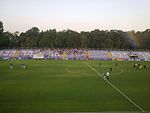Yazur

Yazur (Arabic: يازور, Hebrew: יאזור) was a Palestinian Arab town located 6 kilometers (3.7 mi) east of Jaffa. Mentioned in 7th century BCE Assyrian texts, the village was a site of contestation between Muslims and Crusaders in the 12th-13th centuries. During the Fatimid period in Palestine, a number of important people were born in Yazur. In modern times the town was the birthplace of Ahmed Jibril, the founder and current head of the Popular Front for the Liberation of Palestine – General Command (PFLP-GC). The Israeli town of Azor now stands on the former town lands of Yazur, which was depopulated and mostly destroyed during the 1947–48 Civil War in Mandatory Palestine.
Excerpt from the Wikipedia article Yazur (License: CC BY-SA 3.0, Authors, Images).Yazur
Sprinzak,
Geographical coordinates (GPS) Address Nearby Places Show on map
Geographical coordinates (GPS)
| Latitude | Longitude |
|---|---|
| N 32.026111111111 ° | E 34.804722222222 ° |
Address
שערי תשובה
Sprinzak
5804543 , Shikun Gag
Tel Aviv District, Israel
Open on Google Maps











